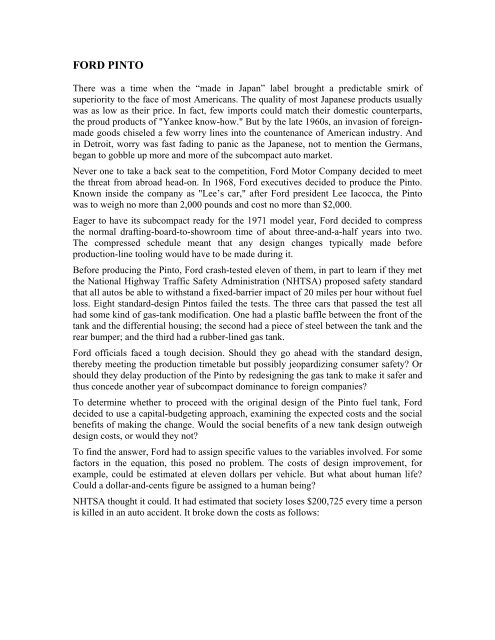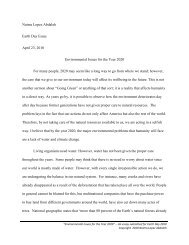FORD PINTO
FORD PINTO
FORD PINTO
Create successful ePaper yourself
Turn your PDF publications into a flip-book with our unique Google optimized e-Paper software.
<strong>FORD</strong> <strong>PINTO</strong>There was a time when the “made in Japan” label brought a predictable smirk ofsuperiority to the face of most Americans. The quality of most Japanese products usuallywas as low as their price. In fact, few imports could match their domestic counterparts,the proud products of "Yankee know-how." But by the late 1960s, an invasion of foreignmadegoods chiseled a few worry lines into the countenance of American industry. Andin Detroit, worry was fast fading to panic as the Japanese, not to mention the Germans,began to gobble up more and more of the subcompact auto market.Never one to take a back seat to the competition, Ford Motor Company decided to meetthe threat from abroad head-on. In 1968, Ford executives decided to produce the Pinto.Known inside the company as "Lee’s car," after Ford president Lee Iacocca, the Pintowas to weigh no more than 2,000 pounds and cost no more than $2,000.Eager to have its subcompact ready for the 1971 model year, Ford decided to compressthe normal drafting-board-to-showroom time of about three-and-a-half years into two.The compressed schedule meant that any design changes typically made beforeproduction-line tooling would have to be made during it.Before producing the Pinto, Ford crash-tested eleven of them, in part to learn if they metthe National Highway Traffic Safety Administration (NHTSA) proposed safety standardthat all autos be able to withstand a fixed-barrier impact of 20 miles per hour without fuelloss. Eight standard-design Pintos failed the tests. The three cars that passed the test allhad some kind of gas-tank modification. One had a plastic baffle between the front of thetank and the differential housing; the second had a piece of steel between the tank and therear bumper; and the third had a rubber-lined gas tank.Ford officials faced a tough decision. Should they go ahead with the standard design,thereby meeting the production timetable but possibly jeopardizing consumer safety? Orshould they delay production of the Pinto by redesigning the gas tank to make it safer andthus concede another year of subcompact dominance to foreign companies?To determine whether to proceed with the original design of the Pinto fuel tank, Forddecided to use a capital-budgeting approach, examining the expected costs and the socialbenefits of making the change. Would the social benefits of a new tank design outweighdesign costs, or would they not?To find the answer, Ford had to assign specific values to the variables involved. For somefactors in the equation, this posed no problem. The costs of design improvement, forexample, could be estimated at eleven dollars per vehicle. But what about human life?Could a dollar-and-cents figure be assigned to a human being?NHTSA thought it could. It had estimated that society loses $200,725 every time a personis killed in an auto accident. It broke down the costs as follows:
Future productivity lossesDirect $132,000Indirect 41,300Medical costsHospital 700Other 425Property damage 1,500Insurance administration 4,700Legal and court expenses 3,000Employer losses 1,000Victim’s pain and suffering 10,000Funeral 900Assets (lost consumption) 5,000Miscellaneous accident costs 200Total per fatality $200,725 1Ford used NHTSA and other statistical studies in its cost-benefit analysis, which yieldedthe following estimates:BenefitsSavings:180 burn deaths; 180 serious burn injuries;2,100 burned vehiclesUnit cost:$200,000 per death; $67,000 per injury;$700 per vehicleTotal benefit: (180 x $200,000) + (180 x $67,000)+ (2,100 x $700) = $49.5 millionCostsSales:Unit cost:11 million cars, 1.5 million light trucks$11 per car, $11 per truckTotal cost: 12.5 million x $11 = $137.5 million 2Since the costs of the safety improvement outweighed its benefits, Ford decided to pushahead with the original design.Here is what happened after Ford made this decision:12Ralph Drayton, "One Manufacturer's Approach to Automobile Safety Standards," CTLA News 8(February 1968), p. 11.Mark Dowie, "Pinto Madness,'' Mother Jones, September–October 1977, p. 20. See also RussellMokhiber, Corporate Crime and Violence (San Francisco: Sierra Club Books, 1988), pp. 373-382; andFrancis T. Cullen, William J. Maakestad, and Gary Cavender, Corporate Crime Under Attack: The FordPinto Case and Beyond (Cincinnati: Anderson Publishing, 1987).
Between 700 and 2,500 persons died in accidents involving Pinto fires between 1971 and1978. According to sworn testimony of Ford engineer Harley Copp, 95% of them wouldhave survived if Ford had positioned the fuel tank over the axle (as it had done on itsCapri automobiles).NHTSA’s standard was adopted in 1977. The Pinto then acquired a rupture-proof fueltank. The following year Ford was obliged to recall all 1971-1976 Pintos for fuel-tankmodifications.Between 1971 and 1978, approximately fifty lawsuits were brought against Ford inconnection with rear-end accidents involving the Pinto. In the Richard Grimshaw case, inaddition to awarding over $3 million in compensatory damages to the victims of a Pintocrash, the jury awarded a landmark $125 million in punitive damages against Ford. Thejudge reduced punitive damages to $3.5 million.On August 10, 1978, 18-year-old Judy Ulrich, her 16-year-old sister Lynn, and their 18-year-old cousin Donna, in their 1973 Ford Pinto, were struck from the rear by a van nearElkhart, Indiana. The gas tank of the Pinto exploded on impact. In the fire that resulted,the three teenagers were burned to death. Ford was charged with criminal homicide. Thejudge presiding over the 20-week trial advised jurors that Ford should be convicted if ithad clearly disregarded the harm that might result from its actions, and that disregardrepresented a substantial deviation from acceptable standards of conduct. On March 13,1980, the jury found Ford not guilty of criminal homicide.For its part, Ford has always denied that the Pinto is unsafe compared with other cars ofits type and era. The company also points out that in every model year the Pinto met orsurpassed the government’s own standards. But what the company does not say is thatsuccessful lobbying by it and its industry associates was responsible for delaying for 9years the adoption of NHTSA’s 20-miles-per-hour crash standard. And Ford’s criticsclaim that there were more than forty European and Japanese models in the Pinto priceand weight range with safer gas-tank position. "Ford made an extremely irresponsibledecision," concludes auto safety expert Byron Bloch, "when they placed such a weak tankin such a ridiculous location in such a soft rear end."
















